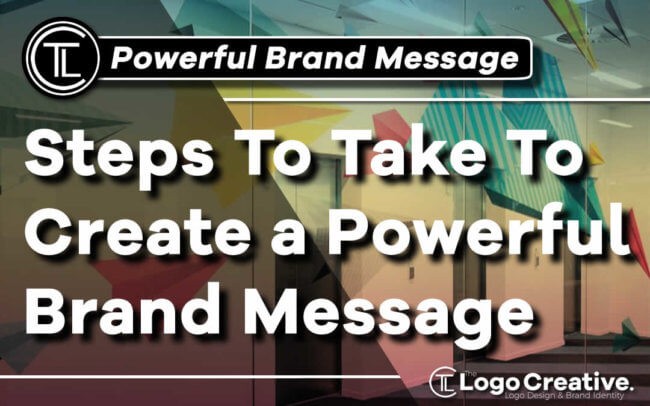A powerful brand message doesn’t appear overnight. Communicating your brand to the world can be challenging. In this article we discuss the Steps To Take To Create a Powerful Brand Message.
To effectively tell your brand’s story, you need a strategic approach to design your brand, as well as skilled designers, deep thinking, and a great understanding of your brand identity.
It seems a bit intimidating, but a successful brand message can help you articulate your brand in a simple, powerful way, create strong relationships with your target audience and ultimately convert them into sales.
Hopefully, the step by step guide below can help you create a compelling brand message.
To clearly present who you are, what you want to achieve, and how you will do it, you need to define your brand identity first.
Table of Contents
What Is Brand Identity?

Brand identity is beyond your logo, color palette, and style. It presents the way your brand looks, feels, and communicates with people.
It’s a way to differentiate your company from competitions, interact with the world, and make a brand experience that engages people.
To be a successful and competitive company, you have to develop a robust brand identity design.
If you can properly present yourself to the world, you can better interact with people and create strong relationships needed to have long-term success.
When designing your brand identity, you have to develop a visual language that includes all the aspects of your company from its website to packaging.
It should also work for both your internal employees and the people who communicate with it (e.g., customers). The keys to creating a brand identity are:
- Distinction: a brand identity should be outstanding among competitors.
- Effectiveness: a brand identity should be memorable and make a visual impact on people.
- Flexibility: a brand identity should be aligned with the brand and grow with it.
- Usability: a brand identity should be easy to apply and straightforward for designers to use.
Steps To Create A Brand Message
Creating a strong brand message can seem challenging. But the tips below can help you move through the process much easier.
Whether your brand is in its initial stages or requires rebranding, follow each advice step by step to build a strong brand message.
1. Define Your Brand Strategy
Your brand strategy is a detailed and long term plan for developing a successful brand message. It precisely outlines your specific goals and the way you are going to achieve them.
The brand strategy affects all the aspects of your company related to customers’ expectations, emotions, needs, and competitors.
It includes your brand heart (goals, values), brand message (brand voice and personality), and brand identity (logo and color).
Before you dive into your brand messaging, accomplish the primary work of brand strategy creation, especially your brand heart.
It will help you better understand what message you will communicate to design a strong brand message that sets for your success.
Once you’ve built your brand strategy and got it approved, you can focus on your brand messaging.
2. Know Your Current Brand Message
What is your niche? How do you differentiate yourself from your competitors? This information will influence every aspect of your brand message.
If you want to start a branding project, you need to know your brand’s current state and align it with your specific goals.
The goal here is to understand how your workers and customers perceive your brand.
You can distribute a questionnaire among employees, stakeholders, and customers to get honest reflection and deep dive into your brand’s current state.
Once you have your research done and your current position identified, it’s time to describe what you do better than your competitors in one sentence.
You can write this based on the following template:
Our [your offering] is the only [category] that [benefit].
Repeating this sentence will help you make sure that your brand message expands your current state.
3. Identify Your Personas
Brand messaging is the way you talk about your brand. Whatever your design is, it should precisely communicate your identity.
When creating your brand message, keep in mind that it should not exclusively showcase what your brand wants to present.
It should also fulfill your customers’ expectations and make them accustomed to communicating with the brand.
If a brand message can’t resonate with them, it might not be sufficient.
To identify what you want to achieve, you have to create personas that illustrate every aspect of your target audience.
This will help you understand the psychological attributes of your customers as well as their demographic information.
It will also help if you consider how other groups perceive your brand, including your competitors or potential employees.
It will impact your design decisions too.
4. Recognize Your Competitors
It is essential to know your competitors, their location, and in what way your brand resonates with them.
To get an objective understanding of your competitors and identify their strengths and weaknesses, you should conduct competitive research.
It helps you express the similarities and differences between your competitors and know how they represent themselves in terms of brand personality and visual elements.
For example, if you move through your research, you’ll notice that many brands have the same style. For example, YouTube and Netflix are featured in a red color scheme.
It can be an excellent opportunity to create a new brand style, differentiate yourself, and create an engaging brand message.
5. Write a Creative Brief
Once you know your competitors well, you have the required information to start creating your brand message. But you shouldn’t jump to the design part right away.
First, write a creative brief that precisely covers all the info you need to keep your team members in harmony and ensure your brand message is aligned with your brand.
Remember that a creative brief should not provide too little or too much information. Write an informative brief but do not overwhelm it with odd and superfluous facts.
6. Develop Visual Concepts
Now that you have gained a bunch of information from your personas, competitors, and your creative brief, you should translate this information into visual concepts.
Thankfully, the information you gained is based on your brand’s personality, purposes, and values. The challenge here is to decide how to represent and improve these emotions through visuals.
Gather your team members and ask them to brainstorm words that describe your brand in the best way possible.
Choose words that provoke emotional responses, expand the imagery, and make you visualize your brand most.
For example, if your company is “fast” in providing services, don’t use its synonym like “swift.” Try to find a word that reminds you of the word “fast.”
This will help you create a brand identity that will make people engage with your brand more.
7. Design Your Brand
To develop a powerful brand message, you need a compelling brand identity design. In brand designing, every element influences each other.
The following tips can help you design a brand at the early stages:
● Logo
A powerful logo design depends on team collaboration. Since the logo communicates with your brand, make sure that your coworkers are professionals in their field.
Ask your team member to brainstorm some powerful words and then turn them into vectors. Remember that your logo mark should be legible in different applications.
● Color
When you choose your logo mark, you also need to select your color palette. Your brand color is a great tool used to differentiate yourself from other brands.
When selecting the colors, be creative but not overwhelming. Be careful and choose the colors that trigger strong emotional responses.
● Typography
This stage is somehow tricky. One typography that works for one brand might seem outdated and uninspired for the second.
Choose typography that distinguishes you from your competitors and be flexible and adaptable for many applications.
● Additional Elements
Your brand should be clear, comprehensive, and match unique communication expectations. So, when you design your brand identity, make sure it includes motion graphics, video, interactive elements, and web design.
Consider relevant iconography too. With an appropriate iconography, you can develop more creative visual designs.

8. Polish Your Brand Messaging
Take the final step and polish your brand message:
- How can your brand solve the problem? More importantly, why should people choose you? (Consider the functional and emotional benefits that the brand offers)
- Does it align with your brand identity?
- Does your brand message differentiate you from competitors?
- Does it communicate your brand effectively?
- Is it clear and consistent?
Once you design your brand, ask these questions to check if your brand message works, and refine it if necessary.
Bottom Line
Creating a strong brand message requires a lot of work and collaboration. To keep it powerful, you have to ensure that your team member develops a brand message that aligns with your brand identity and resonates with the right audience.
This step-by-step guide can serve as a great help to create a successful brand message.
Join The Logo Community
We hope you have enjoyed this article about the Steps To Take To Create a Powerful Brand Message.
If you would like more personal tips, advice, insights, and access to our community threads and other goodies join me in our community.
You can comment directly on posts, access our community threads, have a discussion and ask questions with our founder Andrew.
If you’re looking to learn more about brand strategy, we highly recommend eRESONAID with our friend and acclaimed brand strategist and author Fabian Geyrhalter, it’s packed full of knowledge and insights you will need to learn to become a brand strategist or apply what you learn within your own business.
 Author Bio
Author Bio
James Baxter is a professional ghostwriter, editor at write my essay and blogger, who loves sharing his experiences and knowledge. He is especially interested in marketing and IT. James loves to visit different places and meet new people.


